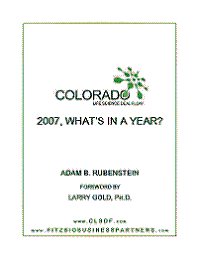
DISCLAIMER: This analysis in no way should be considered investment advice!
In an effort to keep the modeling skills a bit more than dull combined with a deep-rooted curiosity about the development or lack-there-of by big pharma of new anti-infectives I remain fascinated with the progression of Replidyne’s (NASDAQ: RDYN) portfolio, particularly the antibiotic Faropenem medoxomil.
FYI…For those who share my fascination there is an absolutely wonderful look at the entire antibiotic market by Ralph E. Christoffersen, Ph.D., Partner with Morgenthaler Ventures in last years Nature Biotechnology (Vol. 24 No.12) that you can read (here). Not to beat a dead horse but…people and publications of this caliber continue to validate the quality and sophistication of the Colorado bio-scape.
So…I set out to decide if the public markets are fairly valuing Replidyne. Here is the method to my madness: First I dove into attempting to size the potential markets for Faropenem, they include acute exacerbation of chronic bronchitis, bacterial sinusitis, community-acquired pneumonia and pediatric acute otitis media, and for REP8839 pediatric impetigo. Next I looked at the competitive landscape and for the most part decided that the market is highly competitive and thus assigned a relatively modest penetration rate to arrive at the targeted market available for capture. Then it was on to arriving at product pricing so I turned to what I believe to be the competitors such as Augmentin® by GlaxoSmithKline (NYSE: GSK), Omnicef® by Abbott (NYSE: ABT), Zithromax® by Pfizer (NYSE: PFE), Ketek® by Sanofi-Aventis (NYSE: SNY), Levaquin® by Ortho-Mcneil and, Altabax® by GlaxoSmithKline (NYSE: GSK). And considered the current average costs for dosing and duration to then derive a peak sales value.
As if the elements leading up to this next step were not difficult enough to arrive at I was then left to consider the variety of royalty streams. Some variables to consider are the original downstream license for Faropenem from Asubio Pharma and manufacturing relationship with Nippon Soda Supply as well as the upstream commercialization agreements with a to-be-named entity, formerly Forest Labs (NYSE: FRX), so I simply cut it in half and split the difference to yield a peak annual sales number. With this in hand I figured on an increase in sales of twenty percent per year over five years until peak annual sales are achieved. Based on this I then backed out manufacturing and operating costs, working capital and taxes, this left an estimate of free cash flow per indication.
Then an adjustment for risk was considered. I got a bit crazy here considering the safety and late stage data for Faropenem and that an NDA was filed despite the need to hold additional Phase III superiority studies, a generous discount was applied yet cranked it way down for the earlier stage REP8839 opportunities. This then left me with a free cash flow estimate that accounts for developmental risk. The final step is to then discount the free cash flow estimates via the incorporation of a traditional weighted average cost of capital (WACC) methodology. To derive the cost of equity I relied on Bloomberg for the beta and Bankrate.com for the risk-free rate, the market rate I more or less plucked this number out of the air though it seemed ‘reasonable’ to me, throw these elements all together and you have your capital asset pricing model. The final piece to calc’ing a WACC is determining the cost of debt; that was easy to do for as far as I can tell Replidyne is currently servicing no debt. Applying the WACC then left a discounted cash flow for each of the firm assets, sum them all up and there is the theoretical value of Replidyne.
Then I took this summed value and divided it by the number of shares outstanding and came up with a price of $7.01 compared with the trading value at the time of writing this post of $6.39. If my math and a whole lotta other stuff is correct then there is about a 10% price differential and would therefore propose that Replidyne is currently undervalued. But don’t take my word for it, the company recently had analyst coverage initiated by Morgan Stanley and Cowen & CO, and as of last month these folks are calling Replidyne either a buy or a strong buy and have noted a price target of $9.00. So that does lend some validation that my target price was ‘close’ and perhaps my model has some legitimacy but if you look at the delta from a percentage perspective there is a bit of a significant divide.
Anyway you slice it demand for new and more effective antibiotics continue to grow and here in Colorado we are rooting hard for Replidyne’s Faropenem and REP8839. The next earnings call is scheduled for 30 October 4:45pm EST, perhaps we may hear about a new partnership opportunity to replace the Forest Labs deal?
If you are interested in how I derived this value take a look at the model (here).
If you enjoyed this post, get free updates by email (here).
NOTE: Author holds a long position in RDYN.



No comments:
Post a Comment